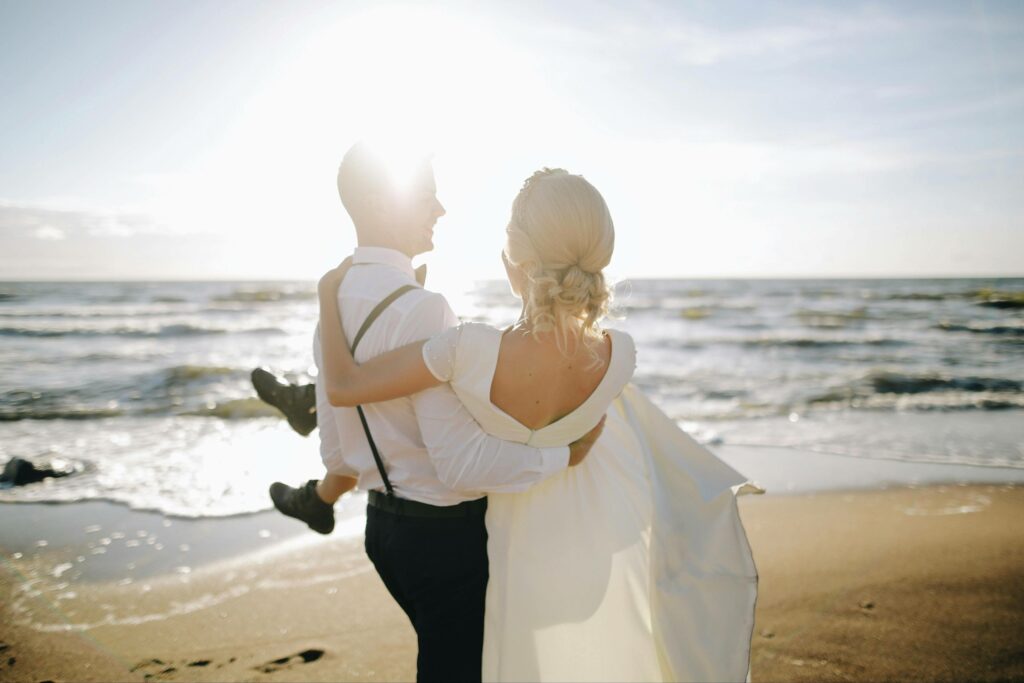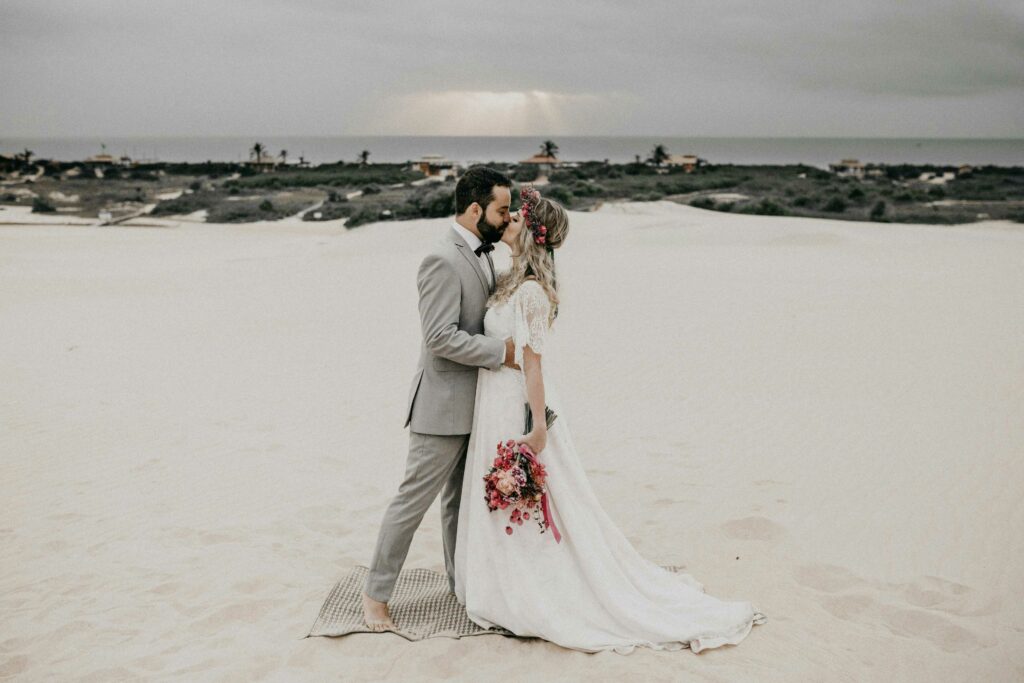The Complete Guide to Beach Wedding Photography
Most photographers dream of shooting a beach wedding until they actually do one. Between shifting light, unpredictable weather, and guests squinting into the sun, even seasoned pros find themselves fighting the elements. The reward, though, is unmatched: golden-hour portraits that feel cinematic and editorial all at once.
This guide breaks down how working photographers approach beach weddings differently, particularly, what gear and camera settings actually work in real conditions, how to handle dynamic light, and the editing workflows that keep colors true to life. We’ll also look at how AI tools like Aftershoot streamline post-processing for outdoor shoots, so you can deliver sun-drenched galleries faster.
Beach wedding photography challenges every photographer faces
- Sun and sand create lighting nightmares: Beach midday light reflects off sand like a giant fill card, creating flat, harsh lighting that requires sophisticated flash techniques to add dimension and mood.
- Wind turns everything into chaos. That gorgeous, flowing dress becomes a management challenge, hair constantly moves, and traditional posing becomes impossible, requiring burst shooting and adaptive direction techniques.
- Equipment protection is non-negotiable. Salt air corrodes gear, sand infiltrates everything, and humidity wreaks havoc on electronics, demanding protective systems and backup equipment strategies.
- Timing becomes critical strategy. Beach weddings offer narrow windows of optimal lighting (early morning, late afternoon), making timeline management and backup plans essential for success.
- Volume shooting requires efficient workflows. Wind and movement mean shooting 2-3x more images than indoor weddings, creating massive culling challenges that can overwhelm traditional post-processing approaches.
Beach wedding portraits: gear, setup & lighting tips
Here's what every beach wedding demands, from ceremony coverage under blazing noon sun to romantic sunset portraits with unpredictable wind:
Camera protection and backup systems
- Weather sealing is essential – Canon R6 Mark II, Sony A7R V, or Nikon Z6 III with robust weather sealing protects against salt air and sand infiltration. Beach conditions will test your equipment's limits.
- UV and polarizing filters – Protect front lens elements from salt spray while reducing harsh reflections from sand and water. B+W or Hoya filters provide protection without compromising image quality.
- Equipment cleaning supplies – Lens cloths, blower brushes, and alcohol wipes for constant gear maintenance. Salt residue builds up quickly and can damage equipment if not addressed immediately.
Lens selection for beach versatility
- 24-70mm f/2.8 for ceremony coverage – Wide enough for beach ceremony setups, long enough for intimate moments, and fast enough for changing light conditions throughout the day.
- 85mm f/1.4 for romantic portraits – Essential for isolating couples from busy beach backgrounds and creating that dreamy separation that makes beach portraits feel romantic rather than chaotic.
- 16-35mm f/2.8 for dramatic landscapes – Capture the scope and beauty of beach venues while including environmental context that shows why couples chose seaside locations.
Lighting equipment for beach portraits
- High-speed sync flash systems – Profoto or Godox systems capable of HSS up to 1/8000s to overpower harsh midday sun while maintaining shallow depth of field.
- Large softboxes or octaboxes – 48" or larger modifiers that create soft, flattering light even in bright conditions. Smaller modifiers get overpowered by beach lighting.
- Sandbags and clamps – Wind will destroy your lighting setups. Weight everything down and secure light stands with clamps designed for outdoor use.
Camera settings
- Manual exposure for consistency – Beach lighting changes constantly as clouds move and sun angle shifts. Use manual mode to maintain consistent exposure across sequences.
- High shutter speeds (1/250s minimum) – Wind creates constant movement. Use faster shutter speeds to freeze flowing fabric and hair movement while maintaining sharp focus on subjects.
- Polarizing filter management – Reduce harsh sand reflections and enhance sky contrast, but watch for uneven polarization effects across wide-angle shots.
How to shoot beach wedding photography step-by-step
Before the shoot
Weather and timing coordination
Beach wedding photography lives and dies by weather conditions and timing strategy. Unlike indoor venues where you control variables, beaches demand backup plans for everything like rain, extreme wind, high tide, and harsh lighting conditions that change throughout the day.
Example timeline strategy: Schedule ceremony for late afternoon (4-5 PM) to avoid harsh midday sun, plan cocktail hour during golden hour for optimal portrait lighting, and build 30-minute buffers for weather delays or location changes if conditions become unworkable.
Location scouting for multiple scenarios
Scout beach venues at different times of day to understand how lighting changes, identify wind-protected areas for intimate moments, and locate backup locations if primary ceremony spots become unusable due to weather or tide conditions.
Note potential challenges: Where does the sun's position create backlighting vs. harsh front lighting? Which areas offer natural wind protection? What backup locations work if the beach becomes unusable?
Equipment preparation and protection systems
Develop systematic approaches for protecting gear from sand and salt while maintaining quick access for changing conditions. This includes rain covers, sand protection systems, and backup equipment strategies for when the primary gear gets compromised.
During the shoot
Lighting techniques that overpower the sun
Beach light is unforgiving. To get dimension in your subjects, you’ll need powerful flash setups that can shape or even overpower the midday sun. Most photographers build their own “sunset” by controlling color temperature and direction instead of waiting for golden hour.
Example technique: For midday ceremony coverage, position large softboxes 45 degrees to subjects and use HSS flash at high power to create directional lighting that adds dimension to faces while reducing harsh shadows created by overhead sun reflecting off sand.
Managing wind and movement
Traditional wedding posing becomes impossible in the beach wind. Develop adaptive direction techniques that work with environmental conditions rather than fighting them, embracing flowing fabric movement, using wind-blown hair as creative elements, and timing shots between wind gusts.
Example direction: Instead of trying to control dress movement in wind, have couples walk toward you while talking naturally, shooting continuously to capture moments when fabric flows beautifully rather than wraps awkwardly around legs.
Dealing with harsh backgrounds and distractions
Beaches often include visual chaos like boats, buildings, and constantly changing backgrounds. Use shallow depth of field, careful positioning, and timing to isolate couples from distracting elements while maintaining environmental context.
Sunset portrait strategy under pressure
Beach sunset portraits offer narrow timing windows, maybe 20-30 minutes of optimal light with unpredictable weather that can eliminate the opportunity entirely. Work efficiently through multiple poses and compositions while managing couple expectations about timing constraints.
Post-processing workflow for beach wedding photography
Editing beach weddings is all about balance, fixing the chaos of natural light without losing its warmth. The sun, sand, and sea create incredible color but also unpredictable contrast and glare. The key is building a workflow that stays consistent across hundreds of outdoor frames while keeping the natural tone clients fell in love with.
1. Fast culling with AI tools
A beach wedding can easily generate 4,000+ images, like waves, wind, and guests rarely wait for you to reframe. Many photographers now use AI-assisted tools like Aftershoot to handle the initial cull, so they can move straight into editing with only the strongest, most expressive shots.
2. Recover highlights and color
Sand and sky throw off exposure fast. Start by pulling down highlights and lifting midtones to bring back skin detail. Set a neutral white balance before adjusting warmth, blue casts from the sea, and reflective glare can skew tones even on balanced cameras. Once you’ve built a reliable base, batch-correct similar lighting sequences for consistency.
3. Build a cohesive look across the set
Every lighting change at the ceremony, golden hour, and twilight receptions creates a new edit challenge. AI-driven editing software can apply your preferred base look across the gallery, helping you maintain a cohesive color narrative while keeping natural light intact. It’s the simplest way to get to 90% done before doing any local refinements.
Beach wedding editing requires hundreds of precise color correction decisions across dramatically different lighting scenarios while maintaining the romantic, cohesive aesthetic that beach wedding clients expect. Aftershoot's AI editing learns your beach photography style from previous coastal work, then applies those same color management decisions consistently across new beach wedding galleries.
4. Retouch for natural texture
Salt air and humidity can make skin shine or soften detail unpredictably. Use subtle skin corrections and glare reduction enough to even things out without flattening texture. Many pros rely on AI retouching tools to handle basic corrections in batches and add their final finesse in Photoshop.
5. Export and Deliver
When everything looks cohesive, export in formats tuned for both digital and print use. Beach photos often appear darker on mobile devices, so add a touch of brightness to your web set while keeping the print versions balanced for album work. Organize folders clearly (ceremony, portraits, reception) and rename files sequentially for a smooth client experience.
Some photographers finalize metadata, watermark previews, and upload directly from their AI workflow tools to keep delivery fast and ready for client review.
Pro tip: Before final delivery, view your gallery on multiple screens. Sunlight-balanced edits can shift dramatically indoors. A quick brightness or warmth tweak can make the difference between “nice” and “wow” when clients open their gallery for the first time.
Popular Beach Wedding Editing Styles
Warm golden hour extension creates that perpetual sunset feeling even for images shot in harsh midday conditions. This style uses strategic color grading to enhance warmth and create a romantic mood regardless of actual shooting conditions, making the entire gallery feel like it was captured during magic hour.

Fresh and airy with ocean-inspired tones emphasizes the clean, refreshing feeling couples associate with beach destinations. This approach uses lifted shadows, enhanced blues and aquas, and careful attention to maintaining natural skin tones despite challenging mixed lighting conditions.

Dramatic and moody coastal cinema works for couples who want their beach wedding to feel epic and artistic rather than just pretty. This editing style embraces contrast, enhances natural drama in skies and water, and uses selective color grading to create images that feel like luxury travel photography.

Explore beach-specific editing approaches in Aftershoot's AI Styles marketplace, where coastal wedding specialists share techniques for handling challenging beach lighting and color conditions.
How much do beach wedding photographers make?
Beach wedding photography commands premium rates thanks to the technical skill, travel logistics, and coastal challenges involved.
- Photographers typically earn $4,000–$12,000 per wedding in coastal markets
- Destination specialists can charge $8,000–$25,000+ with travel and multi-day coverage included
- Established experts in luxury coastal markets can make $200,000–$500,000+ annually shooting 20–35 weddings.
Breaking in often starts at $2,500–$5,000 while building a portfolio that proves consistent quality in difficult conditions. Success depends on mastering factors like weather planning, equipment protection, and travel logistics.
Specialization opens doors to venue partnerships, planner collaborations, workshops, and fine art coastal sales. Though it requires investment in gear, logistics, and skills, the scarcity of true beach photography specialists creates strong ROI potential.
Final Thoughts: Delivering Beautiful Beach Wedding Photos Every Time
No two beach weddings ever look the same. The light shifts every few minutes, the wind does what it wants, and half your job is learning to adapt while keeping things consistent. The successful beach photographers are building reliable workflows that make unpredictable light look intentional.
From pre-visualizing with exposure control to culling efficiently and batch editing for color harmony, the real advantage comes from systems that protect your creative energy. That’s where modern AI-assisted tools quietly earn their place because they take care of the repetition so you can focus on the artistry that clients actually remember.
Beach photography rewards preparation, and when you master the workflow, every new shoreline becomes just another version of your signature light story.
Ready to streamline your beach wedding workflow without sacrificing artistic quality? Try Aftershoot free for 30 days and discover how AI-powered assistance can handle the volume challenges while preserving creative focus for the advanced techniques that define successful beach wedding photography.

